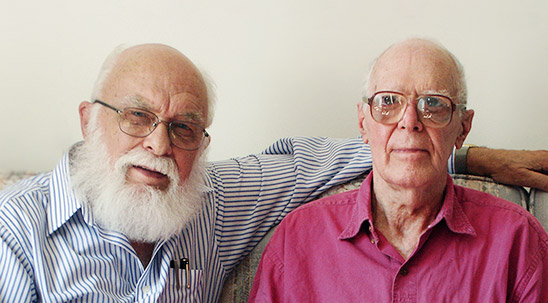By James Randi
What follows is a short essay I wrote for a local newspaper in New Jersey, in the early 60s. It therefore contains anachronisms, and deals with matters as they were at that time. That remarkable man, the subject I wrote about, would have been 100 years of age on October 21, 2014.
What follows is a short essay I wrote for a local newspaper in New Jersey, in the early 60s. It therefore contains anachronisms, and deals with matters as they were at that time. That remarkable man, the subject I wrote about, would have been 100 years of age on October 21, 2014.
 Martin Gardner CC-BY-SA-2.0-de Konrad Jacobs, Erlangen
Martin Gardner CC-BY-SA-2.0-de Konrad Jacobs, Erlangen There's a limited number of persons I have determined to meet at all costs. They include Peter Ustinov, Margaret Hamilton, Margaret Rutherford, and John Archibald Wheeler. But the most prominent person on that list I have already met long ago, and I am privileged to have enjoyed his company, his erudition and his confidence many, many times. He is Martin Gardner.
This remarkable man lives in Croton-on-Hudson, in his private kingdom of Oz at an appropriate address: 10 Euclid Avenue. I've never summoned up enough nerve to ask Martin if he chose the house for its address or for its topology, which I suspect on close examination would prove similar to a Klein bottle. Its many rooms are jammed with columns of full filing cabinets bearing exotic labels reading, typically, "Geometry, plane, solid, 4D and up" and "Combinational Color Cubes, Magic Squares, Logic & Misc. problems." It makes one's mouth water and mind boggle.
His bookshelves boast originals of many classics in the field of mathematics and in the art of conjuring, as well as first editions of all the L. Frank Baum "Oz" books. One section several feet long is devoted entirely to "Hollow Earth" theories and there must be several shelves consisting only of Martin's own books, in several languages and various combinations. A copy machine stands humming at "ready" so that every clipping gleaned may be multiply-copied for filing under as many headings as possible.
Martin files numbers. If a number is shown to be a prime, it is filed under "primes," then given its own file so that other of its specifics may be noted. Is it the sum of cubes? Then it goes into that file, as well. Any peculiarity is described and preserved. I recall the advantages of this system when I was employed by International Business Machines to work up a presentation involving logic, multiple solutions and new ways of approaching problems. IBM was concerned with promoting their series-370 business machines, and I asked Martin about that specific number.
"Aha!" he said - thus also inventing a book-title - "the number 370 is one of only four - aside from 1 itself - that are the sum of the cubes of its own digits. What's the next highest one?" I had no answer, and felt like a fool when he told me. It is quite obvious. "And if you're interested in a Spanish connection," he continued, "turn it upside-down." I did, and IBM was happy with the results. I'm sure Martin could have gone on and on with fascinating facts about 370 — or any other number I'd have cared to choose....
Martin Gardner is the most organized person I know. His tastes are simple, but in keeping with his interests. Numerous Escher prints - originals, of course - bought from the artist when no one else cared, grace the walls of #10 Euclid. A few ingenious mechanical devices occupy various shelves, and typically a table may display some puzzle that needs solution. One such was a group of eight letter-cards spelling out "PICTURES." Told that these could be re-arranged to form another English word of eight letters, all I could come up with was, "SCRIPTURE" - leaving me short one "R"….
A silver ring is the only personal adornment I've ever seen on Martin, shaped as a tiny Möbius strip. I suppose that there are numerous other artifacts of this kind about, but that particular shape seems to express the man fully. It is fascinating in a direct and amusing way, has many unsuspected facets and possibilities, it is simple and basic, suits him quite well, and attests to his good taste.
At four in the afternoon, after a long day of cerebration, there comes a holler up the winding stairway (counter-clockwise, two complete turns, going up) from wife Charlotte, the only other inhabitant of Oz besides the very proper cat, which one presumes is probably Cheshire. Both their sons are away on their own, returning only occasionally to Emerald City. Four p.m. is "Manhattan time," and deadline or no, Martin breaks from his labors to relax. It's a ceremony carefully observed and respected by all visitors upon pain of banishment. I don't think Martin could drink a Martini. The pun would be more than he could stand...
Closing these few brief observations, let me return to that IBM symposium in San Francisco. After my presentation, I credited Martin with having supplied the raw data for the production, and was pleased to see that the Systems Engineers present gave him a prolonged round of applause in absentia. But I was astonished when, immediately afterwards, I was surrounded by a large group of them who asked me a question: Was Martin Gardner a real person, or a composite? They found it difficult to believe that he was only one person and that he turned out such an astounding amount of material on a regular basis.
To those folks I said, as I say to you: yes, there is a Martin Gardner, and he is a delight and a frustration, a wonder and a good friend to every rational mind. He's rare, generous, thoughtful, shy, valuable and valued all in one. And he would rather I had not written any of this. But I had to.
In the twentieth century, we had Einstein, lunar landing, instant coffee, biorhythms, black holes, and Doctor Matrix. And Martin made it all worth while being here.
This remarkable man lives in Croton-on-Hudson, in his private kingdom of Oz at an appropriate address: 10 Euclid Avenue. I've never summoned up enough nerve to ask Martin if he chose the house for its address or for its topology, which I suspect on close examination would prove similar to a Klein bottle. Its many rooms are jammed with columns of full filing cabinets bearing exotic labels reading, typically, "Geometry, plane, solid, 4D and up" and "Combinational Color Cubes, Magic Squares, Logic & Misc. problems." It makes one's mouth water and mind boggle.
His bookshelves boast originals of many classics in the field of mathematics and in the art of conjuring, as well as first editions of all the L. Frank Baum "Oz" books. One section several feet long is devoted entirely to "Hollow Earth" theories and there must be several shelves consisting only of Martin's own books, in several languages and various combinations. A copy machine stands humming at "ready" so that every clipping gleaned may be multiply-copied for filing under as many headings as possible.
Martin files numbers. If a number is shown to be a prime, it is filed under "primes," then given its own file so that other of its specifics may be noted. Is it the sum of cubes? Then it goes into that file, as well. Any peculiarity is described and preserved. I recall the advantages of this system when I was employed by International Business Machines to work up a presentation involving logic, multiple solutions and new ways of approaching problems. IBM was concerned with promoting their series-370 business machines, and I asked Martin about that specific number.
"Aha!" he said - thus also inventing a book-title - "the number 370 is one of only four - aside from 1 itself - that are the sum of the cubes of its own digits. What's the next highest one?" I had no answer, and felt like a fool when he told me. It is quite obvious. "And if you're interested in a Spanish connection," he continued, "turn it upside-down." I did, and IBM was happy with the results. I'm sure Martin could have gone on and on with fascinating facts about 370 — or any other number I'd have cared to choose....
Martin Gardner is the most organized person I know. His tastes are simple, but in keeping with his interests. Numerous Escher prints - originals, of course - bought from the artist when no one else cared, grace the walls of #10 Euclid. A few ingenious mechanical devices occupy various shelves, and typically a table may display some puzzle that needs solution. One such was a group of eight letter-cards spelling out "PICTURES." Told that these could be re-arranged to form another English word of eight letters, all I could come up with was, "SCRIPTURE" - leaving me short one "R"….
A silver ring is the only personal adornment I've ever seen on Martin, shaped as a tiny Möbius strip. I suppose that there are numerous other artifacts of this kind about, but that particular shape seems to express the man fully. It is fascinating in a direct and amusing way, has many unsuspected facets and possibilities, it is simple and basic, suits him quite well, and attests to his good taste.
At four in the afternoon, after a long day of cerebration, there comes a holler up the winding stairway (counter-clockwise, two complete turns, going up) from wife Charlotte, the only other inhabitant of Oz besides the very proper cat, which one presumes is probably Cheshire. Both their sons are away on their own, returning only occasionally to Emerald City. Four p.m. is "Manhattan time," and deadline or no, Martin breaks from his labors to relax. It's a ceremony carefully observed and respected by all visitors upon pain of banishment. I don't think Martin could drink a Martini. The pun would be more than he could stand...
Closing these few brief observations, let me return to that IBM symposium in San Francisco. After my presentation, I credited Martin with having supplied the raw data for the production, and was pleased to see that the Systems Engineers present gave him a prolonged round of applause in absentia. But I was astonished when, immediately afterwards, I was surrounded by a large group of them who asked me a question: Was Martin Gardner a real person, or a composite? They found it difficult to believe that he was only one person and that he turned out such an astounding amount of material on a regular basis.
To those folks I said, as I say to you: yes, there is a Martin Gardner, and he is a delight and a frustration, a wonder and a good friend to every rational mind. He's rare, generous, thoughtful, shy, valuable and valued all in one. And he would rather I had not written any of this. But I had to.
In the twentieth century, we had Einstein, lunar landing, instant coffee, biorhythms, black holes, and Doctor Matrix. And Martin made it all worth while being here.
Randi at TAM 2010 reflecting on Gardner after Gardner's then recent death.


